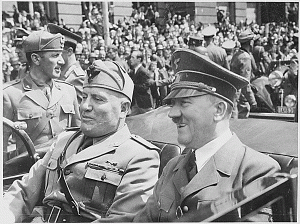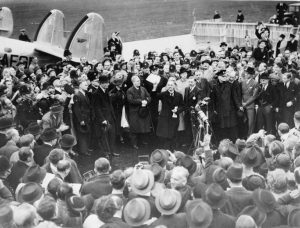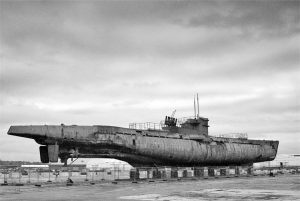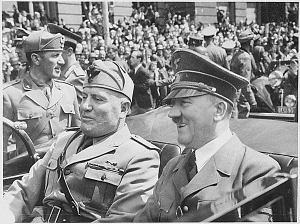WWII in Europe
Causes
The First World War had left much of Europe in an unstable tangle of ruins. Germany in particular felt aggrieved. Due to the Treaty of Versailles, its overseas territories were lost, and much of its land in Europe was ceded to create the Polish state. Reparations crippled its economy and its people were forced to accept blame for the war in the ‘War Guilt Clause’. The situation improved briefly through the 1920s, but the Wall Street Crash of 1929 collapsed the recovering economy, providing a breeding ground for extremism.
Adolf Hitler and the Nazi party’s nationalistic call to end reparations, regain lost territory and prioritise the German race won huge popularity, becoming the largest party in the 1933 elections. Hitler began to tie his party to the state. Other political parties were banned, the Gestapo were formed as a secret police, and his own bodyguards, the SA and SS, were given the same powers as the police. Hitler left the League of Nations and tied himself closer to Fascist Mussolini and Italy.
Trigger
Neville Chamberlain returning with a declaration of peace between Germany and Britian during the now infamous period of appeasement.
Hitler then began to expand to gain Lebensraum (Living Space) for the German people. He first joined Austria with strong support, and then far more controversially annexed Czechoslovakia. The weakened state and anti-war sentiment of Britain and France led them to a policy of ‘Appeasement’. The USA was following a policy of isolationism, which undermined the League of Nations’ potency, and Japan and the Soviet Union had no interest in challenging Hitler, preferring to expand themselves.
Japan and Germany signed the Anti-Comitern Pact against Communism in 1939. More aggressively, the Nazi-Soviet Pact arranged the division of Eastern Europe between the two countries after a series of annexations. On 1 September 1939, Germany invaded Poland using Blitzkrieg tactics, which the UK and France had pledged to protect. They declared war on Germany on 3 September 1939.
Outbreak
Despite the British and French declaration, the Western frontier experienced very little military action in what became known as the ‘Phoney War’. Soviet forces also invaded Poland on 17 September and Poland formally surrendered on the 5 October. The Soviet Union then annexed the three Baltic states by August 1940. No resistance was offered. However, Finland rejected Soviet forces, starting the ‘Winter War’, a hard-fought conflict of 5 months in which, despite numerical advantage, the Soviets gained little ground and signed a treaty in which the Finns resentfully ceded 10% of their territory. Germany invaded Norway and Denmark on the 9 April 1940, achieving victory on 10 June, despite some resistance from the British Navy. German attention could now turn West to France.
German Advance West
France had prepared for a German invasion with the Maginot Line, a strong series of fortifications extending across the Franco-German border. The majority of French forces were centred in Flanders on the Belgian border, expecting the German invasion here as the First World War. Instead Germany passed through the neutral Netherlands, Belgium and Luxembourg before invading to the South on 13 May.
The French army was separated from the majority of France, and the Allied forces were put firmly on the retreat. France went with shocking speed. Paris was besieged and occupied, the government fled, Italy declared war on 10th June, and France surrendered on the 22. Moreover, the surrender was signed in the same train carriage as the German surrender on 1918, specifically arranged by Hitler in order to humiliate France.
British forces were trying to retreat from France and were stranded on the wrong side of the English Channel, with 400,000 trapped at the port of Dunkirk. The German tanks were forced to wait for their infantry to catch up, but time was limited and great causalities were expected. The bold Operation Dynamo was launched. A fleet of both military and civilian ships, over 800 strong eventually, was raised and sent to rescue the trapped troops, whilst the last 40,000 French troops fought a delaying action. Only 68,000 men were lost, in what became known as the ‘Miracle of Dunkirk’, but all the British heavy equipment had to be left. The Germans were left to plan an invasion of Britain, but first aerial superiority and neutralisation of the powerful British Navy had to be achieved.
Battle of the Atlantic
The naval battle between the European powers and allies was the longest and most complex of the war. Whilst the Phoney War happened on land, a German U-boat (submarine) sank a British passenger liner, the SS Athenia, within hours of the declaration. The German Navy could not challenge the British and French Navy, and instead relied on attempting to blockade Britain, which as an island was reliant on imports, via submarines (U-boats) and air attacks.
The German U-boats caused particular issue, traditionally used as lone ambushers of trading vessels. The Allied reaction was to create convoys, groups of 30-70 merchant ships guarded by war vessels. The Germans developed the Rudeltaktik (Wolf-pack) system, where many submarines would attack a singular convoy, overwhelming the defending war vessels. Most damaging was the US refusal to accept British intelligence, leading to 500 unescorted being ships being sunk before they developed their own convoy system.
Winston Churchill commented, “the only thing that ever really frightened me during the war was the U-boat peril”. But the crisis was averted with new technology, especially better weapons and radio, the long-range aircraft Liberator, equipped with centimetric radar, and crucially ‘Ultra’ intelligence. This was from the decoded ‘Enigma’ messages, a German code that regularly changed, broken by code breakers at Bletchley Park, England. Despite this, the battle was costly with many vessels wrecked. 75-85,000 allied seamen, and shockingly 28,000 of 41,000 of the German U-Boat men lost their lives.
Battle of Britain
Following victory in France Hitler planned ‘Operation Sealion’ – the invasion of Britain. To do so though, superiority in the sky was essential. The Luftwaffe (German Air Force) outnumbered the RAF in plane numbers but the British had two advantages. Their defence system, the Dowding system, was very effective, combining radar, ground defences and fighters into one unit; and their fighter aircraft were superior, especially the Hawker Hurricane and Supermarine Spitfire.
The Luftwaffe begun their attack on 12 August and targeted British airbases, aiming to destroy radar stations and runways. The RAF took heavy losses but compensated by recruits from places such as New Zealand, Australia, Canada, South Africa, and Rhodesia (now Zimbabwe), occupied Belgium, France, Poland and Czechoslovakia, and neutral Ireland and USA. No.303 Polish Squadron was the highest scoring unit of the battle. The Civilian Repair Organisation also out-produced and repaired Germany, putting nearly 5,000 aircraft back into battle.
On 7 September, thinking the RAF near beat, the Luftwaffe shifted focus to bombing London and other major cities in what became known as the ‘Blitz’, in which London was bombed for 56 of the next 57 days. Although this greatly damaged the British residents, the RAF recovered and forced Operation Sealion to be indefinitely postponed.
Balkans and Greece
Italy had already annexed Albania prior to the outbreak of war. Upon its onset, Italy also invaded Greece in October 1940 but was an initial disaster, the Greeks in fact pushing the Italians back into Albania.
Germany, with aid from Italy, Hungary and Bulgaria invaded Yugoslavia in April 1941 dividing it up into Croatia and Serbia. However, a strong rebel group formed under the would-be Communist leader Josip Tito which gained great success, eventually liberating the country.
After initially defeating Yugoslavia, Germany moved south into Greece. Although there was fierce resistance, the German army succeeded in flanking the majority of the Greek army facing the Italians on the Albanian front. By May, resistance had ended on the mainland the allied force retreated to Crete.
The Battle of Crete was started by a nearly entirely airborne invasion by German paratroopers. The Germans faced fierce civilian opposition, with locals picking off paratroopers with whatever weapons were available. However, by the end of the second day, the Germans had taken most of the North and the allied evacuation begun. Resistance continued, especially through spy rings orchestrated by the British through figures like John Pendlebury, until his death during the German invasion, and Patrick Leigh Fermour, who most famously succeeded in abducting the German commander, General Kreipe.
Greece played little part in the allied counter-movement, and indeed Crete was the last German-held zone to surrender, in the Villa Ariadne at Knossos.
Africa
On 13 September, Italy invaded Egypt, a British colony, via its own colony, Libya. The goal was to gain control of the Suez Canal, a vital link for Britain to her colonies in Asia, and to gain access to the oil-rich Middle East. Britain and her allies under Archibald Waver numbered initially only 36,000 to the Italians’ estimated 150,000. However, Waver weathered the initial storm and then pushed back and defeated the Italians, capturing 130,000 men.
However, Waver was weakened as his troops were diverted to Greece and East Africa, where the Italians had expanded out of Abyssinia, modern Ethiopia, but were then countered from Kenya and forced to surrender. Worse for the Allies, Hitler reinforced Mussolini on 11 February 1941 with Major-General Erwin Rommel’s Afrika Korps, landing at Tripoli.
Fighting in desert conditions was brutal: disease was common, extremes of high temperature in the day and low at night was testing, and supplies, especially water were easily stretched. This meant there were several large advances and then losses. Rommel’s coordination of infantry and tanks was very effective and eventually the Allied troops were pushed back into Egypt. But a stand at Alamein halted the Germans, and a second battle there started a long retreat all the way to Tunisia. This was aided by the creation of the SAS, the now elite unit, that sabotaged behind enemy lines. The US and allied troops also invaded Morocco with success. On 7 April 1943, 250,000 Axis troops surrendered.
Middle East
The Middle East also proved a complex theatre of war. Italy maintained strong relations in Iraq, a British colony, and launched a propaganda campaign that succeeded in causing a coup by Rashid Ali, and an independence movement. Vichy France also allowed Germany to move planes into Syria to aid the rebels. However, the better trained British garrison defeated Ali and re-occupied Iraq. Moreover, this was used as a pretext to invade and occupy Syria and Jordan, colonies of Vichy France, by Britain with Australian and Indian troops.
In August 1941, British and Soviet troops also invaded Iran, desiring access to the oil fields due to the strain on oil caused by the German Naval Blockade. The Shah was deemed pro-German and so despite his neutrality, was ousted and replaced by his son, who favoured the Allies.
Eastern Front
On 22 June 1941, Germany invaded the Soviet Union, codenamed Operation Barbarossa. It has become known as the bloodiest conflict in history, with around 15 million soldiers killed, 10 million captured and 20 million civilians killed. The majority of war crimes, including the Nazi death camps, happened in this conflict and partisan warfare in occupied territories was ruthless with extensive rape and destruction, often at the cost of local civilians.
The German invasion gave no warning, and by September had made large gains in the Baltic States, Belorussia, the Crimea and Ukraine, most importantly Kiev in which 400,000 Soviet troops were captured. Over the next two months though the advance slowed: the increasingly wintery conditions slowed vehicles, grounded the air force for long periods, and suited the better prepared Soviet army. Still, Germany advanced within 30km of the Kremlin in December, but the bitter conditions, often 43 degrees below freezing, halted advances with Moscow and Leningrad (St. Petersburg) remaining untaken.
A battle-hardened German soldier in Stalingrad, 27 November 1942. Photo by Friedrich Gehrmann. Julius Jääskeläinen, Flickr Creative Commons
The Soviet Counter-Offensive in early 1942 relieved Moscow of immediate danger, and the delay allowed troops in the East, stationed in fear of a Japanese invasion, to be brought over. The German Army pushed hard in the South, to take the oil-rich Caucuses and the important city of Stalingrad in one push. Here the war turned. Soviet forces surrounded Stalingrad in the Winter of 1942 and trapped 300,000 Axis troops there. The fighting was bitter, often hand-to-hand in the streets. The average life-expectancy for a Soviet private was just 24 hours in this battle. But Soviet victory here meant by Spring 1944, their invasion of German lands could begin.
Home Fronts
The nations involved in World War 2 came into a state of ‘Total War’, meaning all society including the civilian population and infrastructure is mobilised for war and so also a military target.
Most countries had learnt from World War 1 and introduced measures immediately. Rationing was common and a high percentage of women were mobilised in the work place to replace the men fighting. In Britain, millions of children were ‘evacuated’, either to the countryside to escape the German bombings or some even abroad to the USA and Commonwealth. Propaganda became of critical importance. Political and social divides, such as religion in Russia and traditional female roles, were abandoned in communal patriotic spirit of unity.
In occupied territories, life was hard as supplies were limited and often prioritised to the occupying forces. Germany requisitioned 15% of French food output, and kept 1.5 million soldiers as prisoners, with their wives only receiving a small allowance to compensate. 1 in 10 were forced to resort to prostitution. In areas such as the Eastern Front, where the land was still contested, conditions were worse. Food was short, especially in Europe where Germany even used starvation as a deliberate tactic, and disease was rife.
Holocaust
The Nazi party had since 1933 used policies of anti-Semitism, alienating Jews from certain professions, restricting their rights, and encouraging hatred in events such as Kristallnacht in which 267 synagogues were destroyed. Concentration camps were set up from 1933, the first being Dachau, as a way of holding Jews, as well as other ‘undesirables’ such as homosexuals or political enemies, and using them in forced labour. Prisoners were collected from throughout occupied territory, first in Ghettos in cities such as Warsaw, and then were later systematically transported to these camps.
The lives of prisoners were of little consequence and conditions were poor. However, they were not the same as extermination camps, introduced in 1941. At the Wannsee conference, German officials were informed of the ‘Final Solution to the Jewish Question’. This was a euphemism for the extermination of the Jewish race. Camps such as Auschwitz-Birkenau, Treblinka and Sobibor, were set up to systematically kill as many inmates as possible. The preferred method of execution was in gas chambers which were filled with lethal cyanide-based Zyklon-B or engine gases. However, mass shootings, starvation and exhaustion were also widespread. Dead bodies were then burnt in mass crematoria.
With the German line retreating, many camps were evacuated and forced into death marches. The camps were dismantled, and gas chambers destroyed in order to deny any crimes. The allied forces eventually caught up and liberated many of the prisoners but were shocked and appalled with what was found. It is estimated 6 million died as a result of the Holocaust, and 11 million once other ‘undesirables’, especially Soviet POWs, are added.
Allied Invasion of Italy
Following victory in Africa, the Allied forces moved to invade Italy. On 10 July 1943, there were amphibious and airborne attacks on Sicily, taking Messina opposite the toe of Italy on 10 August. On 25 July Mussolini was ousted and the new government began negotiations with the Allies. On 3 September, allies crossed the Straits of Messina into Italy, and the government surrendered the same day.
However, Germany was prepared and began to occupy the Northern half of Italy, disarming Italian troops there. Such troops provided an issue for the Germans not only in Italy, but areas occupied by both countries such as Greece and Yugoslavia. There were large numbers of POWs that needed to be housed leading to disasters such as the sinking of the SS Petrella, SS Oria and Tanais by the Allies, in which thousands of POWs died.
The Germans developed ‘the Winter Line’ of defence to the south of Rome which halted Allied advance. Mussolini was imprisoned by the Allies in Hotel Campo Imperatore in the Gran Sasso mountains but was rescued by an ambitious glider raid and returned to Vienna before being placed as puppet leader of the new Italian Social Republic in Northern Italy. In Spring 1944, the line was broken and in June, Rome captured. The war in Italy now slowed, as focus shifted to France, and the Allied force was made up of a force of over 16 nations, with surrender achieved on 2 May 1945. On 28 April, Mussolini was captured and executed by firing squad. The bodies were then taken to Milan and unceremoniously strung up in front of a filling station.
Operation Overlord
Operation Overlord was the Allied invasion of France from across the English Channel. Preparations were extensive. Hitler brought Rommel from Africa to prepare a defence, the Atlantic Wall, which he focused around Calais, nearest to England, with the best weaponry possible including the V2 rockets, the first military missiles.
However, the Allies preferred Normandy as it was more open and less defended. An extensive deception campaign was launched with fake radio transmission, dummy tanks and trucks in Dover opposite Calais, and double-agents to convince the Germans the invasion was planned on a different date at Calais or even in Norway.
Ports were also avoided, being better defended, and Mulberry ports, portable breakwaters and piers that could be quickly placed, were developed as well as the ‘Hobart’s Funnies’, special tanks designed for amphibious attacks by attaching flamethrowers, mine flails, or in the shape of a ramp which could be used by other tanks to scale sea walls.
Beaches were selected with the Americans assigned Utah and Omaha, the British Sword and Gold, and the Canadians Juno. Initial plans were delayed by bad weather. However, on 6 June, the landings failed in advancing to their planned positions, but all landed successfully, despite great losses, especially at Omaha, with 160,000 troops landed, to be followed eventually by over three million more.
End of War
Operation Overlord was backed by Operation Dragoon in Provence opening up a front across France. Progress though was slow in both France and Italy as the Germans remained on the defence. A last counter-offensive failed though and left advance open to the Allies against a more vulnerable line. The Rhine was crossed in January 1945 and the last German troops in the West surrounded in the Ruhr.
The Soviets also had rapidly advanced through Eastern Europe and moved in on Berlin. Following Mussolini’s death, Hitler realised the end was near. Even as the Battle of Berlin raged on, orchestrated by the ragged remains of the army, police and even the Hitler Youth and civilian militia, Hitler committed suicide on 30 April 1945. German unconditional surrender was achieved on 8 May, known as V-Day in Europe.
Peace
At the Potsdam Conference, a peace treaty was arranged by ‘the Big Three’: the Soviet Union, USA and UK. Germany was to be divided in four, between these three and France, and would be demilitarised. All annexations of Germany would be reversed, and their territory in the East reduced by 25%, whilst the Soviet Union and Poland gained land. The Nuremburg Trials were also set up to try the Nazi officials for war crimes, especially regarding the Holocaust.
The War had been the bloodiest in history with 50-60 million estimated dead, but even in peace, the possibility of war raised its head. With Europe in ruins, the superpowers of the USA and Soviet Union were left. Germany, especially Berlin, with its divided sectors would become a battleground for the Cold War. Europe, and especially Germany, would take decades to recover from the conflict, with its repercussions still felt strongly today.
More information:
Read: New Series: Ultimate Blitzkrieg – The WW2 Battle of Crete
Read: World War II: The D-Day Landings
By Wilfred Sandwell














